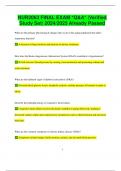NUR2063 FINAL EXAM *Q&A* |Verified
Study Set| 2024/2025 Already Passed
What are the primary physiological changes that occur in the aging population that affect
respiratory function?
A decrease in lung elasticity and increase in airway resistance.
How does the Renin-Angiotensin-Aldosterone System (RAAS) contribute to hypertension?
RAAS increases blood pressure by causing vasoconstriction and promoting sodium and
water retention.
What are the hallmark signs of diabetic ketoacidosis (DKA)?
Elevated blood glucose levels, metabolic acidosis, and the presence of ketones in urine or
blood.
Describe the pathophysiology of congestive heart failure.
Congestive heart failure involves the heart's inability to pump effectively, leading to
decreased cardiac output and compensatory mechanisms such as fluid retention and increased
heart rate.
What are the common symptoms of chronic kidney disease (CKD)?
Symptoms include fatigue, fluid retention, anemia, and elevated blood pressure.
1
,Explain how systemic lupus erythematosus (SLE) affects multiple organ systems.
SLE is an autoimmune disorder that can cause inflammation and damage in various systems,
including the skin, joints, kidneys, and heart, due to the production of autoantibodies.
What role do antidiuretic hormone (ADH) and aldosterone play in fluid balance?
ADH promotes water reabsorption in the kidneys, while aldosterone increases sodium
reabsorption, both contributing to the regulation of blood volume and pressure.
What are the signs and symptoms of hyperthyroidism?
Signs include weight loss, heat intolerance, increased heart rate, and anxiety, while
symptoms may involve excessive sweating and tremors.
How does inflammation contribute to the development of atherosclerosis?
Inflammation leads to endothelial damage and the accumulation of lipids, resulting in plaque
formation in arterial walls, which narrows the arteries and increases the risk of cardiovascular
events.
What is the relationship between asthma and airway hyperresponsiveness?
In asthma, the airways are overly sensitive to various stimuli, leading to bronchoconstriction
and inflammation in response to allergens or irritants.
Describe the mechanism of action of anticoagulants such as warfarin.
2
, Warfarin inhibits vitamin K epoxide reductase, which is essential for the synthesis of clotting
factors II, VII, IX, and X, thereby reducing the blood's ability to clot.
What are the primary clinical manifestations of pneumonia?
Common manifestations include cough, fever, shortness of breath, chest pain, and sputum
production.
Explain the role of the liver in metabolism and detoxification.
The liver metabolizes nutrients, produces bile for digestion, and detoxifies harmful
substances, including drugs and alcohol, through enzymatic processes.
What is the pathophysiological basis of chronic obstructive pulmonary disease (COPD)?
COPD is characterized by persistent airflow limitation due to progressive lung inflammation,
often resulting from long-term exposure to irritants such as tobacco smoke.
How does acute renal failure differ from chronic renal failure in terms of recovery?
Acute renal failure can often be reversed with prompt treatment, while chronic renal failure
leads to permanent kidney damage and requires long-term management such as dialysis or
transplantation.
What are the clinical indicators of anaphylaxis?
Rapid onset of symptoms, including difficulty breathing, swelling of the face and throat,
hives, and a drop in blood pressure, indicating a severe allergic reaction.
3
, What is the difference between a sign and a symptom? Sign - Objective (Erythema, Edema,
lesion)
Symptom - Subjective (Headache, sore, tired)
Na - Sodium 136-144 mEq
Hyponatremia - anorexia, gastrointestinal upset, poor skin turgor, dry mucous membranes, blood
pressure changes, pulse changes, edema, headache, lethargy, confusion, diminished deep tendon
reflexes, muscle weakness, seizures, and coma |
Hypernatremia - increased temperature, warm and flushed skin, dry and sticky mucous
membranes, dysphagia, increased thirst, irritability, agitation, weakness, headache, seizures
K - Potassium o 3.7-5.2 mEq |
Hypokalemia - muscle weakness, paresthesia, hyporeflexia, leg cramps, weak and irregular
pulse, hypotension, dysrhythmias, electrocardiogram changes, decreased bowel sounds,
abdominal distension, constipation, ileus, and cardiac arrest|
4




